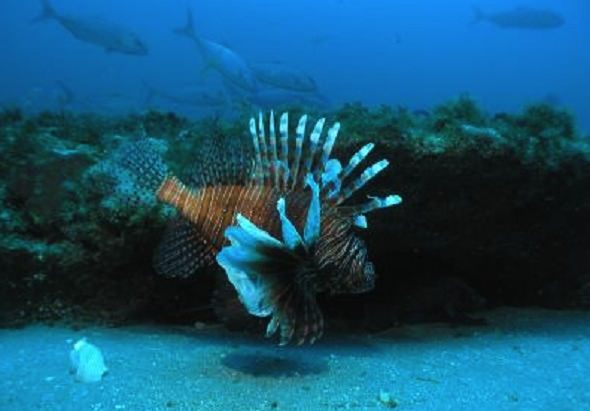Warmer Atlantic Widens Invader’s Hunting Ground
The exotic lionfish, already a long way from the reefs of its Indo-Pacific home, is heading further north up the U.S. coast as global warming causes big changes in ocean habitats.
By Tim Radford, Climate News NetworkThis piece first appeared at Climate News Network.
LONDON — The venomous lionfish is on the move. This invasive species has been observed in deeper waters off the North Carolina coast since the turn of the century, but new research suggests it may now be expanding its range into the shallower levels.
Since the lionfish (Pterois volitans) is actually native to the Indo-Pacific region, it is already a long way from home. But what now gives it licence to hunt further north is warmer sea temperature.
Global warming has already begun to make huge differences to ocean habitat. The bluefin tuna is a temperate zone fish that has already been observed in Arctic waters off the coast of Greenland, and commercial species such as red mullet, a creature of the Mediterranean, has been seen in the North Sea and even in Norwegian waters.
Now researchers in the US have reported that the lionfish — an invader first observed off the Florida coast in the 1980s — is spreading through the north-west Atlantic.
Temperature is the key determinant for a fish on the move. Fisheries biologist Paula Whitfield, of the National Oceanic and Atmospheric Administration’s National Centres for Coastal Ocean Science, and colleagues report in the journal Marine Ecology Progress Series that they surveyed 40 species of fish off the reefs of North Carolina.
Tropical species
These reefs have always been home both to temperate and tropical species, at the limits of their ranges. But now the reefs are becoming more tropical — and so is the local population.
“Along the North Carolina coast, warming water temperatures may allow the expansion of tropical fish species, such as lionfish, into areas that were previously uninhabitable due to cold winter temperatures,” Whitfield says.
“The temperature thresholds collected in this study will allow us to detect and estimate fish community changes related to water temperature.”
The lionfish tends to prefer water warmer than 15.2°C, and so normally inhabits the warm currents of the deeper waters in the temperate Atlantic. It is a carnivore that seems to enjoy a wide range of prey. It makes itself at home in a wide variety of habitat, and is considered a serious threat to other species of reef fish.
Your support matters…Independent journalism is under threat and overshadowed by heavily funded mainstream media.
You can help level the playing field. Become a member.
Your tax-deductible contribution keeps us digging beneath the headlines to give you thought-provoking, investigative reporting and analysis that unearths what's really happening- without compromise.
Give today to support our courageous, independent journalists.






You need to be a supporter to comment.
There are currently no responses to this article.
Be the first to respond.